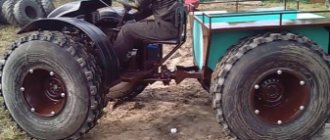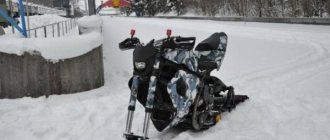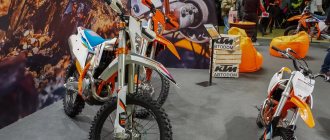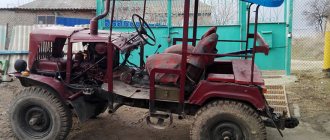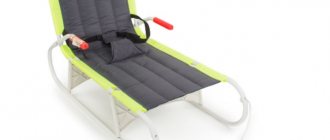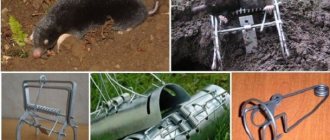The mini-all-terrain vehicle must overcome road obstacles, water obstacles, and swamps. To do this, it needs: a powerful engine, a robust design, and a reliable tracked or wheeled drive. Car enthusiasts assemble such vehicles with their own hands based on their existing cars or buy ready-made kits for production.
Maximum technical characteristics of a homemade all-terrain vehicle
To perform special tasks, mini-all-terrain vehicles must have sufficient technical capabilities. These include:
- Engine power - up to 200 hp. The Nick brand has this indicator. Most homemade versions use a Lifan engine with a power of 18-20 hp. For motorcycle-based models, the figure is 7-8 hp.
- Engine capacity on the Tinger Scout is up to 1100 cc. cm. On the Patrol Truck all-terrain vehicle - 708 cubic meters. cm, and the tank holds 38 liters of fuel. On most models - up to 250 cc. cm.
- The carrying capacity is higher for tracked vehicles. Thus, the Dozor can lift 600 kg of cargo, the weight of 6 people including the driver, and tow up to 2 tons. For wheeled versions, the high figure is 300 kg.
- The maximum speed is up to 60 km/h, which is available to the Patrol Truck all-terrain vehicle. It can move through snowdrifts at a speed of 30 km/h. Although for tracked versions the average speed is 20 km/h.
Car owners choose models based on a wide range of characteristics, such as the number of gears, suspension travel, ground clearance, etc. Depending on the tasks that the vehicle will perform, the buyer selects its technical characteristics.
Required Tools
In the instructions for assembling all-terrain vehicles, manufacturers provide recommendations for working on the installation of the product, detailed drawings, and the sequence of operations. They include a list of tools that can be used to make homemade vehicles:
- Set of auto tools.
- Mechanical gripper for small parts.
- Set of chisels.
- Mini portable flexible LED lamp.
- Screwdriver.
- Drill.
- Bulgarian.
- Gas soldering iron.
- Household welding machine.
- Compressor.
- Spray gun, etc.
Drawings of various modifications
Homemade all-terrain vehicles are assembled according to the drawings of kit kit manufacturers. But in Russia there are many masters who offer their own schemes.
They post detailed descriptions with calculations and diagrams on social networks.
There are special sites on the Internet that host various homemade devices. The following types of drawings can be used:
- Schemes for all-terrain vehicles on tracks or wheels.
- Description of individual components and assemblies.
- Layout options and exact dimensions for wheeled and tracked models.
- The design of the frame, axles, wheel alignment units, steering knuckle, etc.
When designing and constructing, the car owner can take advantage of the suggestions of the masters, make his own adjustments and get a transport convenient for himself.
DIY making
Farmers often prefer to buy a homemade all-terrain vehicle with low-pressure tires, since such a device has a higher speed. However, tracked counterparts are extremely popular due to their advantages.
The production of such devices takes place in several stages. The first step is to search for a drawing of a suitable model, as well as prepare the materials necessary for assembly. After this, it is advisable to begin manufacturing the tracks of the future all-terrain vehicle and its further assembly.
Blueprints
Since the sale of homemade all-terrain vehicles on tracks is in great demand among consumers, many decide to make such a unit on their own. In order to avoid mistakes and design a functional vehicle, it is strongly recommended to constantly check the drawing of the selected model.
Required materials and tools
Before proceeding directly to manufacturing, the craftsman needs to prepare the necessary equipment and materials. In addition to the standard set of tools, assembly requires an angle grinder, a welding machine, and a powerful drill. In addition, you should prepare the necessary materials in advance:
- sheet metal or a finished body from an old car;
- engine from a motorcycle or car;
- wheels, rims;
- conveyer belt;
- profiled pipe;
- fasteners;
- various spare parts for vehicles.
The actual list of necessary materials and tools may differ significantly and depends on the selected all-terrain vehicle model, as well as the changes that the master plans to make to its design.
Assembly order
After the tools and materials have been prepared, it is advisable to begin the assembly procedure of the unit. If the master does not have a conveyor belt, he will need to make tracks. The simplest option is a tape made from rubber tires of suitable thickness. You will need to cut off the sides of the tires, as well as remove excess layers of rubber, after which you can proceed directly to the manufacture of the all-terrain vehicle:
- Construct the base of the device using the body of old equipment or assembling it from steel sheets.
- Install the rear axle - front and rear suspensions, consisting of a strut and steering bushing. For this purpose, a VAZ or other domestic car axle is suitable.
- Mount the rims on the frame, then cover them with caterpillar tape.
- Install the power unit, transmission and brakes.
Since the brake system and gearbox seem too complex for self-assembly, it is strongly recommended to take similar components from unwanted motorcycles or cars. It should be noted that if the master plans to assemble an all-terrain vehicle capable of moving through water, it is important to make sure that the body and other structural components are completely sealed.
Instructions for assembling a tracked all-terrain vehicle
Manufacturers of kit kits and individual craftsmen offer detailed descriptions of assembling all-terrain vehicles on caterpillar tracks. This is one of the most difficult options to make yourself.
To work you will need the following parts:
- Body. It is cut out of metal according to the required parameters or taken as a basis from the VAZ one.
- Sheets of metal.
- Engine, gearbox, axles, steering wheel, levers and other chassis components.
- Brake pads or disc systems.
- Seats for the interior, made by yourself, or taken from other cars.
- Wheels and hubs.
- Tracks, fangs for caterpillars, conveyor belt.
- Corner.
- Profiled pipe, etc.
The sequence of work is as follows:
- The drive axle is assembled, placing the gearbox and planetary mechanism.
- Install the engine on the frame.
- The motor is connected to the drive wheels by installing a transmission gear.
- The body of the all-terrain vehicle is placed on the mechanisms.
- The caterpillar is assembled from tracks and fangs on the basis of a conveyor belt.
Snow and swamp vehicle
These all-terrain vehicles with a sealed body are capable of swimming and moving through swamps, snow, and rough terrain. They come in wheeled, tracked and complex wheel-tracked types. Low pressure tires are used for the wheels.
Oil workers, gas workers, and the Ministry of Emergency Situations travel on factory-assembled all-terrain vehicles. Hunters and fishermen buy ready-made kits, build according to drawings proposed by other inventors, or come up with amphibian designs themselves and assemble homemade units. The work uses automotive components, the Lifan engine.
Lightweight and passable option
To go fishing or pick mushrooms, you need a small, inexpensive, but passable all-terrain vehicle. To achieve this, the design lightens the rear axle and uses a shortened base. An all-terrain vehicle is built on the basis of a walk-behind tractor.
Homemade snow and swamp-going vehicles with a Chinese or VAZ automobile engine, with a gearbox and other transmission components manufactured at domestic automobile industry enterprises have more power.
The main criteria for choosing a mini-all-terrain vehicle:
- Patency.
- Power.
- Buoyancy.
- Load capacity.
- Soil load.
Description of the tracked all-terrain vehicle
You can often find advertisements, for example, “I will buy homemade tracked all-terrain vehicles,” which is due to the numerous advantages of this type of device. They are universal vehicles that can move off-road without any difficulty. This is especially important for people living in rural areas and who need to transport goods or travel long distances. Homemade all-terrain vehicles will be excellent helpers for hunters and fishermen, as they will allow you to quickly and effortlessly get to your fishing spot.
Tracked units have a number of features that should be studied before assembly. They will require a fairly large amount of materials, so you should prepare everything you need in advance. Devices with a caterpillar drive are significantly superior in cross-country ability to their wheeled counterparts, but are inferior to them in terms of speed.
Specifications
Selling homemade all-terrain vehicles on Avito seems to be a fairly successful business, as evidenced by the large number of advertisements. At the same time, the technical characteristics of devices directly depend on the components used during design and assembly.
There are quite a few standard models that are produced using components from old vehicles, walk-behind tractors and similar equipment. The operating parameters of the device and its functionality are largely determined by the engine, which can be a car or a motorcycle. The first option is distinguished by impressive power, allows you to develop quite high speeds and move on sticky soil, while motorcycle analogues are much more economical. For such purposes, it is recommended to use power units with a power of at least 22 hp, otherwise the device’s movement speed will be extremely low and it will not be able to overcome serious obstacles.
The weight of home-made structures, as a rule, is at least 650 kg, which is due to the abundance of automotive elements installed in the structure.
Review of famous mini all-terrain vehicles
Every year new models of small all-terrain vehicles appear on the market from automobile manufacturing enterprises and self-taught designers. Vehicles differ from each other in power, technical characteristics, functionality and price. A review of models is compiled according to the characteristic that unites them.
Among amphibious tires, the following brands are noted:
- ZIS-5;
- KIT-TM-06;
- ZID Barkhan;
- Shogrash;
- VEPS.
Their cost ranges from 170 to 330 thousand rubles.
The tracked range of mini-all-terrain vehicles is represented by the following models:
- Tinger Scout 420;
- Pelec Mini:
- RASH;
- Mirage T;
- Okhotets and others.
They cost from 190 to 400 thousand rubles.
Model Hunter
The 6-wheeled amphibious all-terrain vehicle Okhotets has a beautiful appearance and high technical capabilities. The unit is capable of lifting weights up to 300 kg. It is equipped with a Chinese Lifan engine with a power of up to 18.5 hp.
All components and parts are completely similar to VAZ spare parts. They are easily replaceable, because available for sale.
Therefore, it is easy to repair and reliable in operation.
The cost is 220-339 thousand rubles. depending on modification and configuration. This is a lightweight all-terrain vehicle, it fits in a light trailer or Gazelle body.
Pelec mini
A compact tracked all-terrain vehicle, this helps it move through dense forests. The complete package includes the following additions:
- roll cage;
- awning;
- tow bar, etc.
Pelets mini easily overcomes forests, high steeps, steep banks, holes and ravines. It can remain in water for a long time due to the sealed body structure.
The Karakat has a gasoline engine, centrifugal clutch and hydraulic disc brakes, a spacious interior for the driver, passengers and luggage.
Main characteristics
| Name | Index |
| Engine | 15 hp |
| Weight | 535 kg |
| Maximum speed on land | up to 30 km/h |
| Maximum speed on water | up to 3 km/h |
| Price | from 287 thousand rubles. |
Rush is quite large in its category
The Rush all-terrain vehicle is one of the largest in size among the line of mini-all-terrain vehicles. It will not fit in the back of a Gazelle or in a car trailer.
In addition to the size, it differs from the classics in its special pendant.
In it, a rubber track is installed on large-diameter pneumatic rollers. Main characteristics
| Name | Index |
| Engine | up to 27 hp |
| Weight | from 550 kg |
| Maximum speed on land | up to 30 km/h |
| Maximum speed on water | up to 5 km/h |
| Price | from 390 thousand rubles. |
Model Beaver
This is the most durable mini-all-terrain vehicle model. Operates over a wide temperature range. The beaver is used for work in the Arctic and the Far North, and copes just as well with tasks on the slopes of the southern mountains.
The design is based on GAZ.
This is a set that includes a minibus and a diesel tractor. It has a wide track and increased ground clearance. Due to this, he can pass any obstacles. Main characteristics
| Name | Index |
| Engine | 125 hp |
| Weight | 550 kg |
| Maximum speed on land | up to 70 km/h |
| Maximum speed on water | up to 5 km/h |
| Price | 200-500 thousand rubles. |
By creating a model with his own hands, the owner receives as a result an individual vehicle with the necessary characteristics and capabilities. During the design process, he studies the structure of the all-terrain vehicle in detail, and this helps in the repair and operation of the vehicle.
In how many months can 1 person assemble a mini-all-terrain vehicle?
All-terrain vehicle-Snow and swamp vehicle (floating) 4x4
Cash and non-cash payments are possible!!!
Why do you need an all-terrain vehicle?
With the help of a vehicle such as an all-terrain vehicle, you can navigate difficult terrain, which seemed almost impossible just a few decades ago. This car is not afraid of any off-road conditions. As a rule, all-terrain vehicles are often used by hunters, fishermen, or people who simply prefer active recreation in the wild, where a regular car cannot take them.
An undeniable number of advantages makes the all-terrain vehicle an excellent tool for hunting. Thanks to it, you can quickly get to the desired location or even pursue prey through terrain with very difficult terrain without the risk of getting stuck.
The all-terrain swamp vehicle is able to easily move through swampy areas and any off-road conditions. Even young trees and ice will not become an obstacle to the car.
Such equipment is used for laying transmission lines or pipelines, patrolling difficult terrain, geological exploration or construction work, as well as eliminating the consequences of emergency incidents.
We present to your attention the cheapest all-terrain vehicle!
The design is a classic “fracture”, as they are also called “karakat”.
The frame is welded, made of a square profile, consists of two parts, which are connected to each other by a hinge mechanism made from a UAZ steering knuckle.
The engine, already time-tested, simple and unpretentious, single-cylinder Lifan190FD with a power of 15 hp. with electric starter and lighting coil.
In the minimum configuration of the all-terrain vehicle, the engine is started manually, but you can install a battery and use an electric starter.
The wheels are classic “rugged” ones. Made from disused rubber from heavy equipment: URAL Lapot (1200x500). The tire weight is about 20 kg (from the original 80). They are used together with a tube.
Wheels of our own making. There is a special corner inside the disk that prevents the tire from “rotating.”
Gearbox from classic VAZ models
The gearbox is driven from the engine by a belt drive.
Instead of a conventional clutch, a circuit is used that weakens the tension of the drive belt.
Then, using a chain transmission (from an IZh motorcycle), the torque is transmitted to the drive axles. The chain stretches very quickly, so the gearbox mount is made in such a way that the box can be moved and the chain can be tensioned.
Bridges from classic VAZ models
The brakes are hydraulic, but only on the front wheels.
Steering is implemented using a steering rack from a VAZ-2108
Due to the volume of the wheels, the all-terrain vehicle can float.
The rear part of the all-terrain vehicle is a very impressive body. Which, if desired, can accommodate 4 people or some cargo.
The all-terrain vehicle's carrying capacity is stated to be 500 kg.
And now the most interesting thing - how did you manage to make an all-terrain vehicle so cheap? This is due to the fact that most of the spare parts are used for the second time (used ear parts). Wheels, axles, gearboxes, steering, driveshafts are all restored.
But with all this, the manufacturer gives a one-year warranty on its all-terrain vehicle!
Transporting the all-terrain vehicle does not cause any particular difficulties; due to its small size, it fits on a passenger trailer.
ADVANTAGES:
- The 4x4 all-terrain vehicle is a leader in overcoming water obstacles thanks to its high tread and closed conical disks.
- The 4x4 all-terrain vehicle is easy to repair and maintain. Easily accessible and inexpensive spare parts.
- Guarantee of uninterrupted engine operation in the most aggressive conditions.
- A 4x4 all-terrain vehicle can be used all year round for various purposes, unlike snowmobiles (Buran).
SPECIFICATIONS:
Engine: | All all-terrain vehicles are equipped with a LIFAN engine with an electric starter and an 18A lighting coil. |
| Power | 15 hp |
| Shaft location | Horizontal |
| Launch | Electric starter and manual |
| Fuel tank capacity | 6.5 l. |
| Fuel consumption | 374 g/kWh. |
Transmission: | 4-speed from a VAZ car |
Bridges: | From a VAZ car |
Brakes: | Hydraulic |
Frame: | A frame with a fracture unit is installed on the base of the front hub of a UAZ vehicle |
Wheels: | On conical disks based on the Ural and Kamaz all-terrain vehicles |
Dimensions: | |
| Length | 320 cm. |
| Width | 185 cm. |
| Height | 145 cm. |
| Weight | 470 kg. |
Load capacity: | 500 kg (including driver) |
